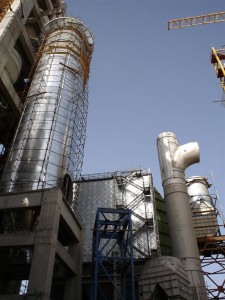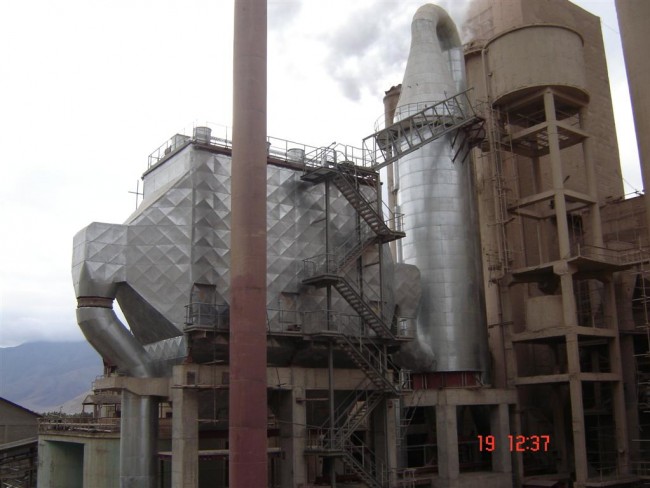The primary function of a cyclone is to separate dust from a gas stream. After separation, the dust discharges out the bottom of the cyclone and air discharges through the top exhaust. Cyclones (or centrifugal collectors) create a ‘cyclonic’ or centrifugal force, similar to water going down a drain, to separate dust from the polluted air stream.
Cooling Tower
The conditioning tower is used to reduce the temperature and to increase the moisture level of the gas, before it is passed through the dedusting equipment. It is called a conditioning tower because it conditions the hot gas, thus making it more suitable for the dedusting equipment to extract dust from it.
The conditioning tower is used to reduce the temperature and to increase the moisture level of the gas, before it is passed through the dedusting equipment. It is called a conditioning tower because it conditions the hot gas, thus making it more suitable for the dedusting equipment to extract dust from it.
The main components of a GCT casing are:
- Inlet
- Gas distribution
- Inspection door
- Nozzle lance
- Outlet
- Dust hopper
The nozzles can be executed as a single-component nozzle, in which the water is aerosolized using high pressure (~ 35 bar), or as a two-component version, in which the water is aerosolized using compressed air.
The nozzles can be executed as a single-component nozzle, in which the water is aerosolized using high pressure (~ 35 bar), or as a two-component version, in which the water is aerosolized using compressed air.
A conditioning tower equipped with a spillback spray system and high-pressure centrifugal pump is designed to force water through a set of nozzles located inside the tower near the inlet. The water pressure energy is sufficient to overcome the water cohesion forces and produce a fine mist. When the gas volume is a small percentage of the design volume, less cooling water is required.
In the mechanical system the water pressure delivered to the nozzles is constant. The excess water (above the volume actually required for gas cooling) is drawn off through an electrically or pneumatically operated two-way control valve and a return pipe to the feeding water tank.
This valve is opened (or closed) to allow more (or less) water to flow back to the water tank and therefore controls the gas temperature.
When the return pipe is totally closed all the water is forced into the conditioning tower for maximum cooling effect.
In a dual media system (water + compressed air) the compressed air provides the energy to overcome the water cohesion and to produce a fine mist. Water at low pressure (about 3 bars) is mixed with compressed air directly in the nozzle.
In comparison with the spillback, this system is more efficient and produces smaller water particles. That reduces the required gas retention time in the tower, then its size.
In the dual media systems, less quantity of gas flow requires reduced cooling water volumes, the particles atomization is not detrimentally affected, since the specific compressed air consumption increases when the water volume decreases.
The water delivered to the ring, which feeds the nozzles, is controlled by a 3-way regulation valve. The excess water is by-passed directly to the feeding water tank.
The temperature control of a conditioning and cooling tower is affected by the thermal inertia of the system, since there is a time gap between what is happening at the tower outlet and at the inlet; this delay corresponds to the treatment time of the gas in the tower (it can vary from a few to 10-12 seconds).
ShayanTarh control philosophy overcomes that time lag by defining the amount of water required by the gas at the inlet conditions. The control system calculates the incoming gas mass based upon temperature, pressure and ID fan speed data. Once the enthalpy of the gas mass is known, the calculation of water to be sprayed is simple. The gas outlet temperature is only used to adjust any possible under or over regulation effect.
Related Posts
- Cyclone
- Wet scrubber
Wet scrubbers are industrial devices for removing dust from gases by spraying liquids. These de-dusting device compared to the others, have some advantage.
- Hybrid Filter
A hybrid filter system has been developed as an air pollution control device that closely integrates electrostatic precipitation (ESP) and fabric filter technologies into a durable, cost-effective device that produces superior filtration results. Its design uses a synergy between these two technologies whereby the filter bags are able to operate at high air-to-cloth (A/C) ratios than conventional pulse jet fabric…



